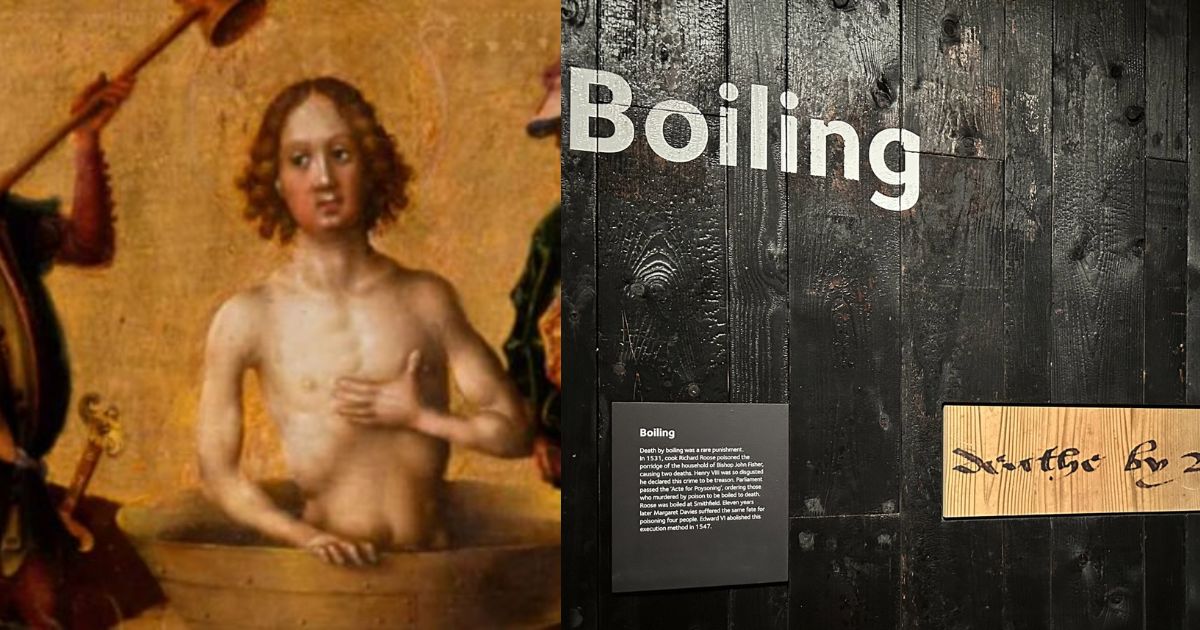Some historical events will make your stomach churn and leave you in disbelief. Here is the story of Richard Roose, a chef, who was accused of poisoning the guests with adulterated porridge at a dinner. His punishment was getting boiled alive publicly in a cauldron. It may be hard to imagine a human getting boiled to death, but that was the punishment for treason in 1531.
This happened in south London in Lambeth when the chef Richard Roose added some suspicious powder to the meal. Some say it was just a joke and not his intentions. Some of the guests died while some got sick, leaving Roose to blame for planning a murder. At that time, King Henry VIII sentenced him to death by boiling for the crime of poisoning the guests.
A lot is not available about the chef’s life, but his execution remains a public event of that time. He was chained to a gibbet that looked similar to a gallow. In his horrific death by boiling alive, he was submerged in the boiling cauldron repeatedly and not just once. He was taken out a few times as he roared loudly in pain.
After that, he was put down to be boiled again. This ordeal went on for two hours before he died. His death was excruciating and painful as he sustained several burns from the high temperature. Eventually, he died, and the cause of the death was trauma and severe burns.
#OTD 1532 Richard Roose publicly boiled to death at #Smithfield. Over a period of 2hrs he was lowered and raised 3 times into a vat of boiling water. He was cook to John Fisher, Bp of #Rochester and accused of attempting to poison him at a banquet after which 2 others died. pic.twitter.com/0kcemm6vPr
— HoT Hogwash (@HogwashHot) April 15, 2023
As per biology, heat burns are limited to the skin cell tissue, but his burns were deep, and he died because of a shock to the body. He suffered thermal burns in which his tissue was destroyed, and there was an insufficient amount of oxygen supply. Being boiled alive, his soft tissue must have contracted, and his skin would have been torn. His muscles and skin would have been reduced fat, causing joint flexing.
Another possible cause of death can be respiratory failure, which often happens in burn victims. The heat damage may lead to blocked and damaged airways, causing the lungs to collapse. According to the documents, Richard Roose had several blisters on his body. Since we don’t know if the cauldron had water, wax, or oil, we may not know its impact on the burns.
#OTD Richard Roose, cook of Bishop Fisher of Rochester, boiled to death for poisoning. He’d added something to the pottage, apparently believing it to be a purgative, done as a joke. 2 people died & Fisher became ill. It was whispered that Anne Boleyn’s supporters were behind it. pic.twitter.com/KUIZjfKJzJ
— Tudor Times (@thetudortimes) April 5, 2023
Many historical accounts have punishments where the accused was placed in cool liquid. The liquid was then heated to the boiling point, eventually killing the person. Many netizens have reacted to the punishment method, calling it horrific and the worst execution.
One user said that even if the person was guilty, such a punishment was still beyond evil. Another user called humans to be the most cruel for putting someone through this. Although this execution method was banned in 1547 by Edward VI, the horror stories are still alive.
Now, we’d only get to see such deaths by accidents. In 2016, a person fell into a hot spring at the Yellowstone National Park in the US. The 23-year-old died as his body was discovered in the spring, and the water was at boiling point. According to WHO, more than 180,000 people die due to burn injuries.













